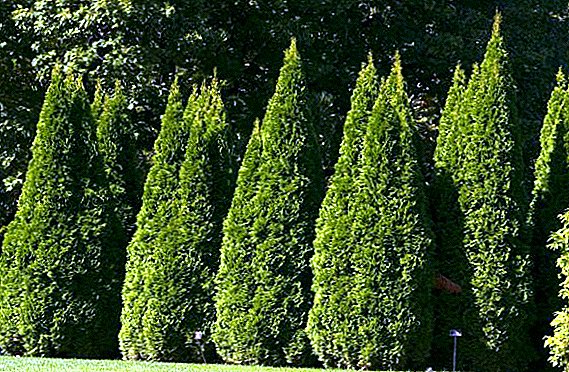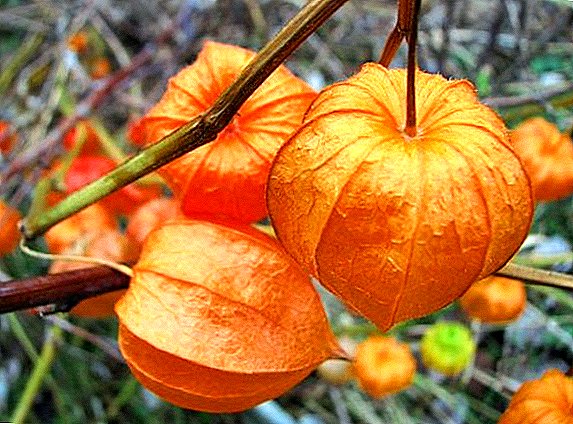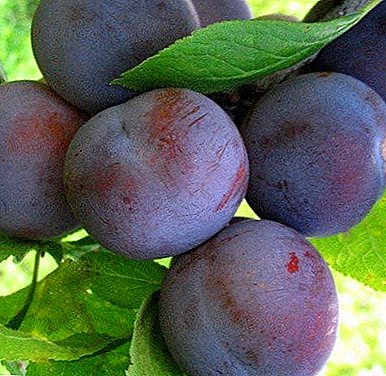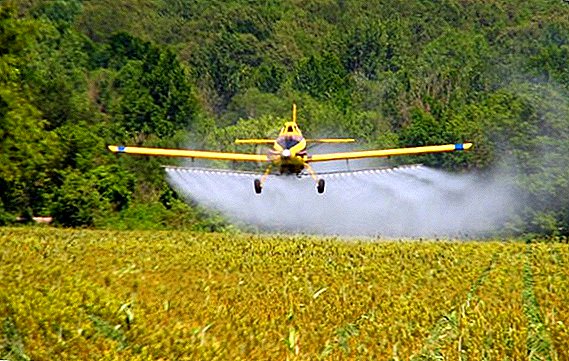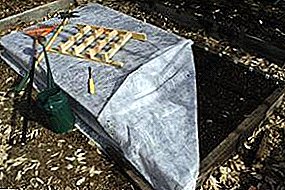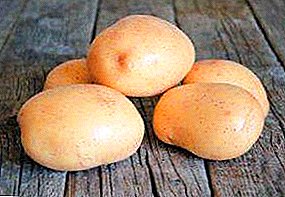 We welcome lovers of the garden! This article will focus on currant pests. We will tell you about what each pest is, how much damage it can do to your currant bush and how to fight it.
We welcome lovers of the garden! This article will focus on currant pests. We will tell you about what each pest is, how much damage it can do to your currant bush and how to fight it.
Did you know? Blackcurrant juice is used to prepare food dyes.
Aphids on currants
 Many gardeners have met with these pests and know about them firsthand. They can not immediately notice, as they are very small, which can not be said about the damage that they cause currants.
Many gardeners have met with these pests and know about them firsthand. They can not immediately notice, as they are very small, which can not be said about the damage that they cause currants.
Aphid is the insect superfamily that feeds on plant sap and can tolerate plant viral diseases.
In addition to the harm that aphids do, she still attracts other insects to the plant (in the process of vital activity, emits a pad - a sweet solution). Thus, if time does not get rid of aphids, then after it your currants can "visit" other pests.
In addition to the "normal" aphids, there are several types that affect currants: 
- gall aphid;
It is a red swelling on the leaves of currant ("treatment" is similar to a simple tle).
 - shoot aphid;
- shoot aphid;
Wraps a young sprout on top of a currant.
The best option would be to tear off these tops and burn (if you leave them in the garden, the aphid will return to the bush).
Important! Do not forget that ants breed aphids and use it as a source of nutrients. They also carry aphids to other plants, so when dealing with aphids, take care of ants too.
Do you have a currant aphid, and you do not know how to treat it? Now we consider possible options that will help you get rid of this problem.
- Infusion on the onion peel. Proportion: 200 g husk per 10 liters of water. Need to insist 5 days.
- Infusion on a dandelion. We take 0.4 kg of leaves and 200 g of the plant itself with roots per 10 liters of warm water. Insist 2 hours.
- Infusion celandine. 1 kg of dry grass per 10 liters of water. Insist one day.
If you do not want to use the "grandfather's" methods, you can use organic insecticides. In this case, you will need a tool that affects the nervous system of the aphid and kills it - Py Spray Garden Insect Killer or Doff All in One Bug Spray.
The most biologically useful option for aphid extermination is settling in your garden of ladybirds, that destroy aphids by colonies. To settle the "suns" in your garden or garden, it is enough to order their larvae and, following the instructions, propagate in your garden.
Processing in the spring. Something special to handle the spring currants from aphids is not necessary. You should cut dried and diseased branchesin which a pest can winter, collect leaves and burn it's all outside the garden. The option of getting rid of the pest can be sprinkling soil near the bush with ashes and of course digging
Did you know? The best soil for currant growth is black earth loam, but it can also grow on other soils, both light and dense. The soil should be sufficiently wet, so in the summer the currants are poured with liquid fertilizers.
Currant Mite
One of the common currant pests is an kidney mite.
Black Currant Mite - it is a microscopic mite that affects gooseberries and currants. It settles in the buds of the plant, which for this reason become more rounded. 
Let us analyze in stages, what is it so scary for a tree. First, from such buds are obtained weak and deformed shoots that barely bear fruit. Secondly, the kidney tick tolerates viral diseases of the currant (terry and mosaic).
Important! If currant struck terry or mosaic, then this bush is not treated and can only be uprooted.
This tick lays eggs in the kidneys in early spring, when currants wake up and rapid growth begins. When the larvae become crowded in one bud, they infect other buds on the tree. The maximum population of pests is observed at the end of currant flowering. After that, their activity decreases.
We turn to the fight against the parasite.
- Boiling water. This is the easiest method of dealing with ticks, which requires absolutely no drugs. In late autumn, when the leaves fell, and the tree began to hibernate, pour boiling water over the currant bush (of course, not 100-degree, but close to it). Thus, you will destroy the tick in the infected kidneys and rid your currants of the pest.
- Plucking infected kidneys. Sufficiently long and time consuming method. It is suitable if you have a small garden. To carry out this "operation" is only in the fall, otherwise you will cut off both infected and healthy kidneys and remain without a crop.
- You can resort to chemicals based on colloidal sulfur, which will certainly destroy the kidney tick. These drugs include Movento, Kontos, Oberon and Judo. They need to handle currants at the time of the nomination of the peduncle, since it is then that the mites are the most vulnerable. Processing is carried out in two stages (re-processing is carried out after 12 days).
Important! Do not allow colloidal sulfur based drugs to get into the gooseberry, as it can get burned.
We do not recommend the use of phosphorus-based drugs because of their toxicity.
If none of the options suits you, you can find varieties of currants that are resistant to kidney mite: In memory of Potapenko, Sevchanka, Nightingale night, Belarusian sweet, Leningrad sweet, Riddle, Kipiana, Leningrad giant, Nara, Oryol Serenade, Otradnaya, Chernysh, Black Pearl.
Shchitovka
Shchitovka - family of hemiptera insects, whose body is covered with a dense shield. They feed on the sap of the plant and lead to its weakening. 
Currant strikes a variety that has the name "Willow shitovka". It is characterized by the characteristic white color of the shield and from a distance it may resemble small cocoons or cobwebs. At the end of June, the female lays several clusters of pinkish larvae.
If they are not found before the cold, then they will spend the winter under the skin of the branches at the base of the bush. If this parasite settled on your young currant, then it will not be so easy to get it out.
The problem is that only the “young” of the shield is exposed to chemicals. An adult can only be mechanically removed from a tree by hand scraping.
To get rid of the young, in early spring the bush is treated with Nitrafen 3% (300 g per 10 liters of water).
If the shoots are densely covered with a parasite, then it is better to cut and burn them, as the eggs of the larvae are located under the scutes themselves, which, if poorly removed, will infect the shrub again.
It will be more difficult to clean adult bushes: after mechanical removal of parasites, it is necessary to process the branches with "Aktellik" (emulsion that destroys a large number of pests). One ampoule of the drug is diluted with two liters of water at a temperature of + 12 ° C and above.
Important! The drug is dangerous for animals and humans, so do not let the chemical in food and water.
When removing the pest, you can also be helped by folk methods, namely: infusions of onion, dandelion and celandine, which were described in detail in the first paragraph of the article.
Currant Galliches

Currant Galitsa - family of two-winged insects that look like small mosquitoes with a brownish-yellow body. Parasitize most often on blackcurrant and gooseberry.
There are larvae flower gall midge (appears during the creation of the buds), leaf midge (appears at the beginning of flowering) and escaping - during the mass flowering of currants.

Gallitsa in the spring lays eggs on currant leaves (at the ends of growing shoots).
These same larvae violate the leaf structure of the young shoot on the tops of the bush, after which the leaf gradually wraps and dries.
After the onset of cold weather, the larvae hibernate into the soil.
Important! The breeding of midge is favored by a strong pruning of the bushes, since this produces a lot of basal shoots.
How to deal with this pest?
Spring can spray currant bushes with insecticides, who cope well with their task. This list includes: Actellic, Karbofos, Rovikurt and others. 
In the summer to fight with gallitsy need as follows: cut damaged shoots without hemp (so that the insect could not enter the new larvae there).
Since the larvae of gall midge overwinter in the ground, in autumn, the ground around the bush must be dug up.
Moth butterfly
Firestorm - Lepidoptera butterfly family. The butterflies themselves do not carry any threat to the plants, unlike the larvae. 
After mating, butterflies lay their eggs in the flower. After the ovary and hatching of the larvae, they penetrate deep into the berries, eat away the seeds and pulp.
One such caterpillar can destroy up to 10 currant berries. You can imagine what harm 10-20 such caterpillars will do.
Fire damage can be identified by rotten berries and a noticeable cobweb, which will be covered exactly currant fruit. The caterpillars finish their protracted "lunch" in early July, descend to the ground under a bush and burrow into the ground by 3-4 centimeters.
Firefight Fight swims out of its life cycle.
- Collect and destroy the affected berries and leaves during ripening.
- In the autumn, after the leaves fall, dig up the soil with the turnover of the reservoir. Spud the bushes with soil from between the rows to a height of 10 cm (since the fireball winters in the ground, then after waking up she will not have enough strength to get out from under the 10-centimeter layer of the earth, and she will simply die).
- Spraying insecticide. For this use Malathion (5 g per 20 liters of water).
Important! Insecticide Karbofos is toxic to humans, but loses this property after heat treatment.
Sawflies
Sawfly - a reddish-yellow insect that parasitizes red currants and gooseberries: damages and eats away the leaves. Adults appear during the flowering of currants. The female lays the larvae on the reverse side of the sheet. Hatching caterpillars eat sheets to the ground. 
With a massive lesion by sawflies, the currant bush can remain completely “naked” and you will not get a harvest (if the bush is young, then it can dry out at all).
Closer to the fall, the sawfly caterpillars descend into the ground (3-4 cm) and pass into the pupal stage. After hibernation, an insect emerges from the pupa, and the cycle repeats.
The fight with the sawfly is like the fight with a fireworm:
- Digging the soil around the bush. In this case, you either dig the pupae to a depth from which they will not get out in the spring, or leave them on the surface where they will freeze.
- Manual collection of tracks from affected sheets. With a strong defeat, you can cut the currant shoots. It is important that not a single caterpillar is left on the bush.
- They use decoctions of wormwood, garlic and tobacco, which are sprayed onto the bushes during the period of the defeat by a caterpillar.
Important! Before using insecticides, carefully study their effects on other plants in the garden, animals and people!
Currant glass bowl
Currant glass maker - a pest butterfly that looks like a wasp. There are about 1 thousand types of glass. 
She has a little fat body with vertical stripes. This individual lepidoptera insects often harms black, red currants and gooseberries.
How to understand that it was the currant glass bowl that spoiled your beautiful berry?
To begin with, the damage from this insect is very significant. Damaged currant branches begin to dry both at the end of flowering and at the beginning of the formation of the berries themselves. With a massive lesion currant bush may die.
In order to identify the pest, It is worth just looking at the branches. If they are dry and there are indentations in the middle, as in the photo, it means that it is worthwhile to start combating pests of currants and gooseberries.
To fight these insects is very difficult. This is due to the fact that they spend almost half of their lives inside the branches.
When you buy currant bushes, they should be properly inspected so that there are no hibernating caterpillars inside the glass case.
The insect often settles in old currant bushes, so it is worth cutting off semi-dry branches as often as possible.
After flowering currant bushes should be treated chemical preparations, such as "Fufanona-Nova", "Kemifos" or "Kinmiks". After all, it is at this time that the glass boxes most often begin to hit the plant.
If you do not want to use chemicals, we recommend using Biologicals - Lepidocid, Bitoxibacillin, Fitoverm. These drugs are safer for humans and nature, are highly effective and easy to use.
Important! When buying new bushes carefully inspect them for the presence of parasites.
That's all you need to know about the processing of currants and gooseberries from such a pest as currant glass.
Currant Zlatka
Black currant zzlatka - This is an insect that looks like a beetle with a metallic greenish sheen. The length of the zlatka is from six to nine millimeters. 
How to determine what exactly zlatka destroys your garden?
Currant berries gradually begin to crumble. At the cut of the branches you will see small passages that are filled with a wormhole. You can identify them in the spring, during the flowering period.
Important! If you treat a currant bush or gooseberry with insecticides, then during the season, zlatki will not parasitize on it, since insects develop only in one generation.
In the case of damaged shoots, the best option would be cut them off and burn. It should be done in the fall or spring. In a week or two after the start of flowering, treat the shrubs with insecticides. Processing should also be carried out after harvest.
At the end of February, spend spring treatment of currant bushes from pests. It is best to treat currants before ripening. The soil under the bush is sprinkled with ash, which will save you from the larvae hibernating in the ground.
During the purchase of bushes carefully inspect the seedlings, because they can be sold with pest larvae.
If necessary, use chemicals. Best suited solution actellica. To handle the bushes is three weeks after the end of flowering.
Currant Kidney Moth
The danger for currants are exactly moth caterpillars, not adult insects. They spoil the kidneys and impair their normal development. The affected buds are lagging behind in development, the yield drops, and in winter the bushes weaken and do not tolerate frosts. 
Most often, the caterpillars winter at the base of the bush and the crevices of the bark. At the beginning of April, adult caterpillars creep up to the tops of the buds, and already in mid-May they descend into the ground to enter the pupal phase.
In early June, the pupae become adult butterflies, which lay eggs in still green fruits. The larvae feed on the seeds of unripe currant or gooseberry berries.
How to deal with such pests currants?
It is best to exercise caution and carry out the prevention of currant bushes or gooseberries. To do this, do the following:
- Clear bushes from dry shoots. Thus, you will get rid of the currant moth larvae, as it will reduce the amount of wintering space.
- Digging up hemp. This will help you get rid of pests inside the soil and update the place of planting new seedlings.
- Thinning landings.
- The purchase of new bushes or seedlings.
If you could not save currants or gooseberries from the larvae of the pest, then you need to start to fight with them. Heavily infected bushes should Chlorofos or Nitrafen should be treated at the end of March.
Against butterflies currant moth suitable processing shrubs "Iskra". Resorting to folk methods, you can use tinctures of mustard, celandine and tomato tops. 
So, we considered the main pests of currants. We learned about what methods you can deal with them and how to prevent infection of the whole garden.
In this article, we gave you a choice between folk remedies and chemicals.
Always be careful when buying new seedlings, as pests often “sleep” on the roots and under the bark. Do not forget the safety rules when using insecticides and other poisons.



